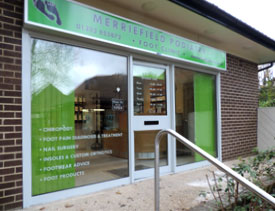Merriefield Podiatry
- Ferndown
- Wimborne
- Bournemouth
- Poole

Call today to book an appointment
t: 01202 855 872
e: merriefieldpodiatry@gmail.com
The heel is the largest bone in the human foot. Heel pain can be disabling occurring at the back, side or bottom of the heel and can be attributed to a variety of causes such as gait abnormalities which places too much stress on the heel, injuries caused by hard surfaces or by wearing badly constructed footwear.
Plantar Fasciitis is a condition where there is a deep pain on the sole of the heel. Burning, stabbing or aching pains are the usual symptoms. It can be caused by pronation (rolling in of the foot) which causes inflammation in the plantar fascia which runs along the bottom of the foot.
Achilles tendonitis is the inflammation of the Achilles tendon as it runs behind the ankle and inserts on the back surface of the heel bone. It is common in people who run or have tight tendons. Where the tendon is strained over time, it causes the fibres to tear and stretch either along the length of the tendon or at its insertion on the heel bone. This leads to pain and the possible growth of a bone spur on the back of the heel bone.
We can provide stretching exercises and insole/orthotic advice to alleviate the symptoms.
The forefoot receives most of the pounding when a person is walking or running as the weight distribution on the sole of the foot is far greater at the front. Common problems affecting the forefoot are hard skin and corns but other disorders can be painful such as nerve compression, inflammation of the tendons, ligaments and joints and stress fractures. Badly-fitting shoes with very thin soles and little cushioning for shock absorption puts pressure on the joints of the foot causing them to become inflamed.
The fatty pad on the forefoot can also thin with age. There is then nothing to cushion the joints from the constant pounding and so the area becomes inflamed. The pain can be exacerbated by the fact the nerve endings are close to the skin.
We can provide advice on footwear and insoles to help with these conditions.
Nail surgery is usually performed for ingrowing nails (IGTN). An ingrowing toenail occurs when a spike of nail penetrates the skin at the edge of the nail. These are often very painful and become infected. Nail spikes can develop through incorrect nail cutting (cut too short), previous injury or fungal infection. Sometimes a wide nail plate may cause the toe nail to in-grow.
Ingrowing toe nails occur when the sides of the nail grown into the skin or there is a build up of hard skin in the sulcis of the nail. Ingrowing toe nails can be very painful commonly affect the big toe nail. Active, sporty people are particularly prone to ingrowing toe nails because they sweat more.
We can cut back the nail to relieve the pressure. If the nail is infected you may need antibiotics. In some cases, it may be necessary to surgically remove part of the nail using a local anesthetic. You can help prevent this condition by not cutting the nails too short and avoiding wearing narrow-toed shoes.
Corns are hard areas of thickened skin in areas of high pressure
We will painlessly remove the hard skin and corns with a scalpel and diagnose the cause of the build-up of hard skin in the first place.
You can help avoid the build-up of hard skin by regularly moisturising your feet with creams that contain urea. Avoid the use of corn plasters as these contain salicylic acid and this could destroy healthy tissue.
When the skin on your heels becomes dry and the body's weight is concentrated on to that area, fissures (cracks) can develop. These cracks can permit bacteria to enter the body and cause infection. We will surgically remove the devitalised tissue to promote healing and discuss measures to avoid the recurrence.
Skin infections in the foot are common. These include Tinea Pedis (Athlete's Foot) Onychomycosis (fungal nail infection) Paronychia (inflammation of the nail fold often associated with an ingrown toe nail) and Verrucae (warts).
Skin infections are prevalent across all age-groups. There are various reasons why such infections occur (closeness of the toes, damaged nails, prolonged wearing of shoes and socks causing increased moisture and bacterial growth). People with diabetes, impaired immune responses and circulatory problems are more susceptible to such infections.
Prompt diagnosis and management are critical to avoid progression to more serious conditions.
You can help avoid fungal infections by daily washing your feet and changing shoes and socks frequently. Ensure that wet shoes are thoroughly dried out before wearing them again.